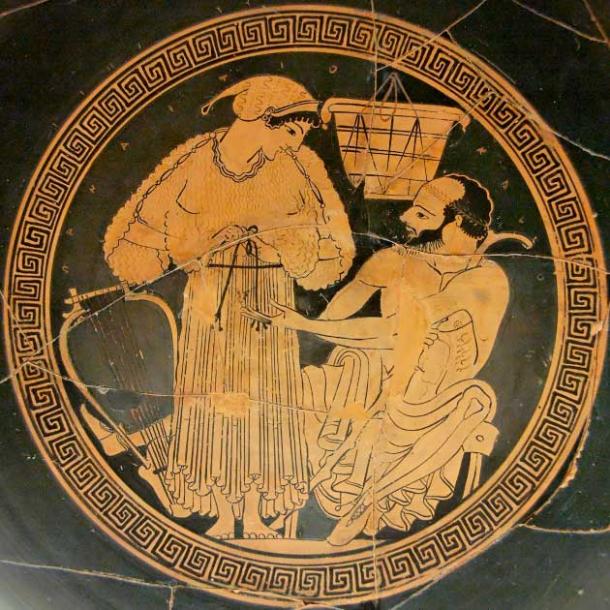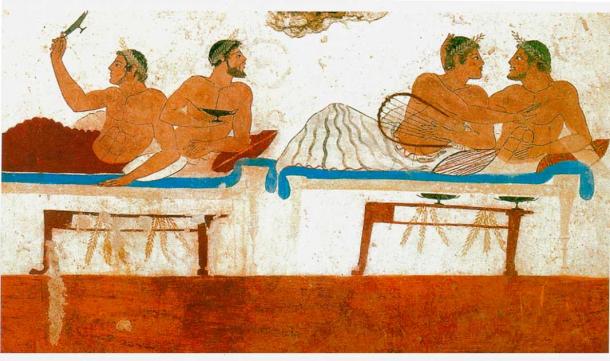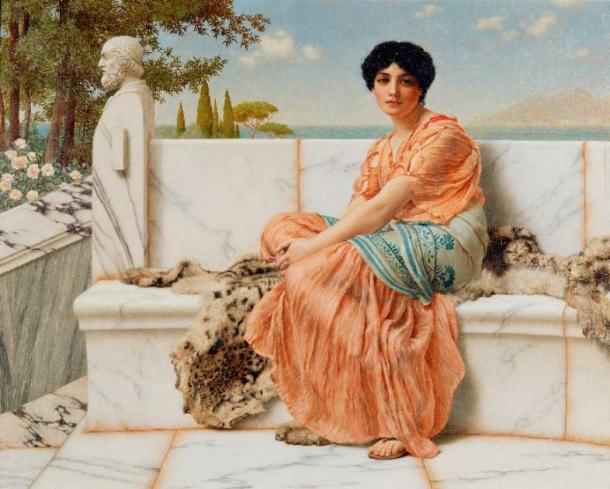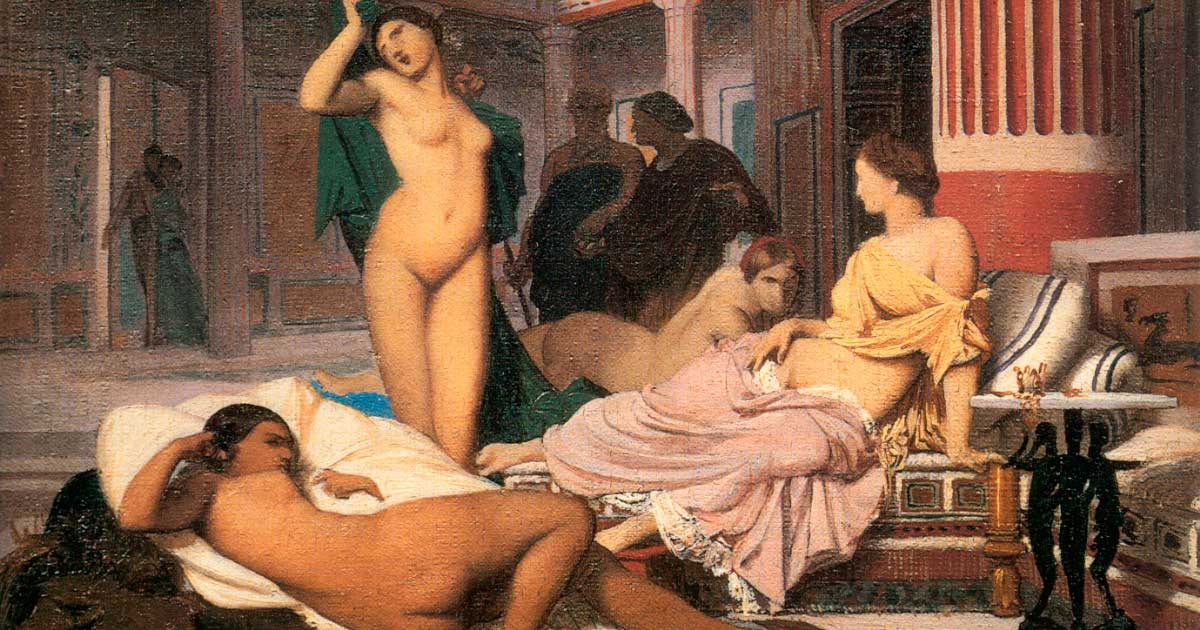Filthy Philaenis? The Ancient Mediterranean Sex Guide that Steamed Up the West
Often referred to as the author of the Mediterranean Kama Sutra, little is known about Philaenis of Samos, who likely wrote this work around the 4th century BC. She is the most mentioned author of the erotic sex guide Joy of Sex, being a rare surviving work by a woman from antiquity. She is mentioned in more than a dozen sources, and fragments of a manual titled P. Oxy. 2891, found in Egypt’s Oxyrhynchus, and published in 1972 seem to trace their attribution to her.
The Joy of Sex: Sentence and Structure
“Philaenis of Samos, daughter of Ocymenes, wrote the following things for those wanting ... life”, begins the work.
The papyrus preserves two adjoining columns from the upper margin of the very beginning of a roll. It commences with a short preamble that introduces the author and the purpose of their work and the second column of the papyrus begins with a new chapter heading, advising the seducer to neglect their appearance.
“Concerning Seductions: Accordingly, the seducer should be unadorned and uncombed, so that he does not [seem] to the woman to be too concerned about the matter in hand,” the manual states.
The sex guide is very practical in nature, written in simple and accessible language, prioritizing the ways of making love easier. There is no erotic rhetoric or literary artifice, and it proceeds to lay out the stages of seduction systematically – flattery, kissing, and ultimately intercourse.

A courtesan ties up her robe again while her middle-aged client washes up. The lyre show her to be a musician called for a banquet, circa 490. (Public Domain)
There is a large segment on how different kinds of women (somatotypes) must make love – petite, bodacious, and pretty are separated, and men are instructed on how to take them. Great parts of this section are missing, so reconstruction has been a little complex.
Who Was Philaenis, alleged author of the ancient sex guide?
Interestingly, Philaenis, who was a Hellenic hetaira, or a female companion herself, was the kind of woman who had professional technique. Thus, she and other hetairas or courtesans were the only ones capable of instructing men in how to take them. Her work covered the best sexual positions, perfumes, cosmetics, means of inducing abortions, and the art of kissing, among others.

The attribution of the ancient sex guide to Philaenis is disputed. Hetaira, oil painting by Franciszek Żmurko circa 1906 (Public Domain)
The only mention of Philaenis outside of this book comes from another preserved papyrus scroll, where Philaenis debunks the myth surrounding her being a hetaira. “I, Philaenis, renowned amongst men, rest here, after living long into old age. Frivolous sailor, you who round the cape, do not mock me, do not laugh, do not despise me. No, by Zeus, in the name of the young people resting underground, I was not a debauched woman with men, offered to anyone. It is Polycrates of Athenian birth, a sort of subtlety of words and a perfidious tongue, who wrote what he wrote. As for me, I know nothing about it,” she is alleged to have written.
The Joy of Sex was written in the same style as The Histories of Herodotus, akin to a history of sex. It was widely read, although publicly condemned at the same time. This disapproval obviously emanated from the fact that a woman potentially wrote such a work, rather than a disapproval of the subject matter itself.
Will the Real Philaenis Please Stand Up?
This is where a certain degree of conflict does arise – that of identity. Many scholars believe that Philaenis was a generic enough Hellenic name under which a few people wrote and compiled this treatise, and those were likely men.
The manner in which it was written reduced the complexity of sex to that of providing pleasure to only men, which is not different from various sex manuals written across history, all over the world. The poet Aeschrion of Samos has claimed that the Athenian sophist Polycrates was the author of the sex guide.
Philaenis was thus also an idea, one that encompassed the elements of sex considered crude or vulgar, including debauchery and prostitution. This ties up with a lesser explored and more closeted question of female homoeroticism and lesbianism, which many conservative male authors have attributed to the idea of Philaenis.
Sandra Boehringer explains, “Philaenis has particular status for another reason. Three times, in Greek and Latin works, her name is found in feminine homoerotic contexts. Yet, while orators’ speeches overflow with accusations or praise for famous men who loved boys, while historians mention names of women who lost their honor in adulterous relationships with men, in the case of documents evoking sexual or loving relationships between women, the names of either fictional characters or real persons are rare.”
The Hidden Fronts of Greek Sexuality
What is particularly interesting in a larger historical context, keeping in mind that Philaenis was a front for a random assortment of unknown male authors, was that Greek society was an active practitioner of pederasty. Adult men, both married and single, had relationships with young boys, generally post-pubescent juveniles.

Male couples at a symposium, as depicted on a fresco in the Tomb of the Diver from the Greek colony of Paestum in Ital (Public Domain)
This is because, in Greek society, sexual desire was not seen as the marker of gender – rather, it was the roles assumed by each participant in the sexual act. This was generally clubbed into active penetrator and passive penetrated, or the dominant and submissive roles respectively. The dominant role was associated with masculinity, higher social status, and adulthood, while the passive positon became associated with femininity, lower social status, and juvenescence.
Love between adult women was not as well documented, although it may be said that etymology of the term lesbian, used for homosexual women, has its origin on the island of Lesbos. Many love poems were written by Sappho, a poet from this island, who left behind close to 12,000 lines of poetry on her love for other women. There are a few other scattered references, but all in all, the love between women was not as well-documented.

Philaenis’ sex guide focused on men pleasuring themselves with women, but sexuality was not so narrow in ancient Greece. "The Time of Sappho", by John William Godward, 1904 (Public Domain)
Clearly, ancient Greece was a land where alternate sexualities were being explored in much more of an open manner than they are in certain societies today. Yet, traits of dominant and submissive have been passed down through the eons, and assume importance in sexual power play even today. Philaenis was clearly someone who held an importance place in society, even though her identity is mythical at this point. Perhaps more finds in the future can help shed more clarity on this.
Top image: Did an ancient Greek courtesan write the first sex guide? Harem Scene, oil painting by Jean-Léon Gérôme, 1848. Source: Public Domain
By Sahir Pandey
References
Boehringer, S. 2014. WHAT IS NAMED BY THE NAME “PHILAENIS”? Available at: https://www.academia.edu/19837193/_What_is_named_by_the_name_Philaenis_Gender_function_and_authority_of_an_antonomastic_figure_dans_Mark_Masterson_Nancy_Rabinowitz_et_J_E_Robson_%C3%A9d_Sex_in_Antiquity_Exploring_Gender_and_Sexuality_in_the_Ancient_World_Routledge_2014_pp_374_393.
Baring Aegis. 2016. A woman to know: Philaenis of Samos. Available at: https://baringtheaegis.blogspot.com/2016/01/a-woman-to-know-philaenis-of-samos.html.
Chards, M.I.C. 2017. The Parody Of A Sex Manual That Sparked The Passions Of The Ancient World. Available at: https://culturacolectiva.com/books/philaenis-ancient-greek-sex-manual/.
Eros & Aphrodite. 2022. Philaenis (the Samian?): authoring a Kama Sutra manual in plain ole Greek and Herodotian style. Available at: https://www.erosaphrodite.gr/blog/12-philaenis-the-samian-authoring-a-kama-sutra-manual-in-plain-ole-greek-and-herodotian-style.
Montserrat, D. 1996. Sex and Society in Græco-Roman Egypt. Available at: https://books.google.co.in/books?id=ciXCT-5XqRsC&q=Philaenis+of+Samos&pg=PA113&redir_esc=y#v=snippet&q=Philaenis%20of%20Samos&f=false.


















Comments
Basically they enjoyed doing exactly as they desired, but the point of modern society is not that we are now more uptight & not so ‘free’ in our attitudes, but that we have over the ages decided that humans have certain rights, and children deserve protection until they are old enough to make their own decisions. Hence pedophilia is banned in current societies, and punished when discovered, and that’s exactly how it should be. Equally males are not allowed now to just ‘decide’ any female they want can be just taken regardless of her choice. So, we have rules for the sake of freedom of choice, some of them we have to carefully guard lest we lose them !!! It does seem however reading about these ancient societies that humans have always had way more sexual interest than is needed for reproduction of the species. We are different from all other species !
Please call a spade what is - a malformed shovel. Pederasty is paedophilia. That in itself is not a good enough term, for 'paedophilia' implies love for children and that is a connection that is meant to deceive. Whatever it is called, it shouldn't be acceptable in any society, polite or otherwise. However, increasingly history is dragged into normalising what should never be normal or acceptable.
It sounds like a university-suggested thesis for the seminar paper. But where’s the counter-argument?
Nobody gets paid to tell the truth.